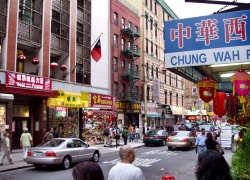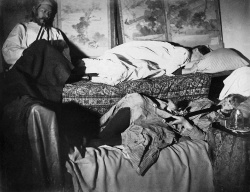From The Peopling of New York City
The Beginning
During Mid-1800’s the cities first Chinese immigrants were recorded. In a census taken in 1855, there were recorded 38 Chinese in New York, all males. The general occupation of these Chinese immigrants was sailors, boarding house owners, proprietors of small businesses, peddlers, and cigar makers. Surprisingly some of the Chinese immigrants married Irish women and became American citizens. By 1873, the New York Times reported around 500 Chinese Immigrants, most of them men, half of which moved to what we now call Chinatown.[1]
Unlike the other immigrants of the 19th century, the number of Chinese immigrants did not increase substantially. During the 1870’s congress declared that naturalization was only for whites and blacks, and Asians were not considered white. Then in 1882, Congress passed the Chinese Exclusion Act, which limited the number of Chinese allowed to immigrate into the United States.
The Chinese Exclusion Act was the first and only law passed by the United States Congress that was an explicitly race-based immigrant act, or one that targeted a specific ethnic group. In addition to barring new Chinese immigrants from coming to the United States, it also made the already present immigrants in United States alien residents. In essence, it did not allow them to be United States Residents.
Due to the Chinese Exclusion Act, a lot of Chinese women whose husbands were in New York were unable to enter New York. Due to this, the Chinese community at this was mostly male who lived lonely lives in cramped quarters. The ratio of men to women exceeded a six to one ratio at this time. With the rise in the male dominant Chinese society, Chinatown was rumored to have opium dens, prostitution, and slave girls, and this further deepened the white antagonism against the Chinese. Chinatown thus became a tourist attraction after 1900, because it came to be seen as an exotic place.[2]The Chinese went on to create guilds among themselves in order to protect their interests, while the On Leong and Hip Song Tongs warred throughout the early 1900's. These wars were often called Tong Wars[3]
Until the repulsion of the Chinese Exclusion act, the number of immigrants entering the United States was generally low. For example, in the 1970's there were only 123,000 Chinese entering; 14,800 in the 1890's and a record low of 5,000 in the 1930's. [4] After being revoked in 1943, the Chinese slowly started growing as a community.
Chinatown Today
Chinatown today has grown from the original ten blocks to the present inclusion of the once Italian and Jewish Lower East Side. The growth of Chinatown is further discussed in Residential Patterns.
References
- ↑ Binder, Fredrick M., and David M. Reimers. All Nations Under Heave. An Ethnic and Racial History of New York City. Columbia UP, 1995. (page 52.)
- ↑ Binder, Fredrick M., and David M. Reimers. All Nations Under Heave. An Ethnic and Racial History of New York City. Columbia UP, 1995. (page 108.)
- ↑ Chinatown
- ↑ Foner, Nancy. New Immigrants in New York. Columbia University Press, 2001. Print. (143)

